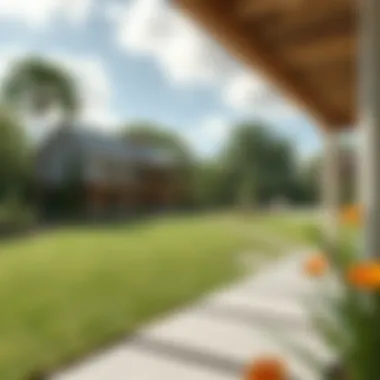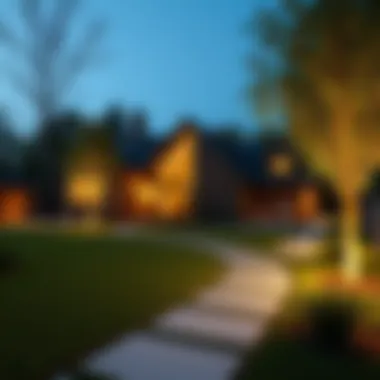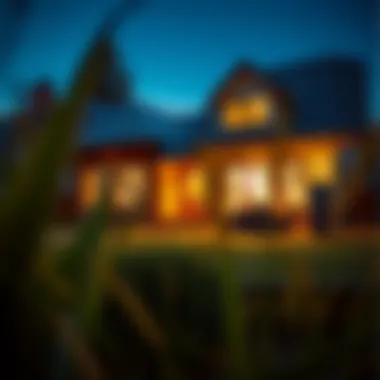Measuring Your Yard Size: An In-Depth Guide


Intro
Measuring the size of a yard is more than just a simple chore; it's a vital step that impacts a variety of domains, from property management to landscaping. Homeowners, real estate agents, and design specialists alike need an accurate understanding of outdoor spaces. This guide offers a blend of traditional techniques and cutting-edge tools, enabling a thorough grasp of yard measurement.
The way a yard is sized can shape its functionality, aesthetic appeal, and even its value. Whether you're plotting out a garden or laying down a patio, knowing exactly how much space you have can lead to smarter decisions.
In this article, we will discuss the significance of accurate yard measurements, delve into an array of methods and tools available, and explain how to choose the right approach for your specific needs. Let's get started!
Preface to Yard Measurement
Measuring yard size is not just a mundane chore; it’s an essential skill that can impact landscaping decisions, property values, and the overall functionality of outdoor space. Whether you are planning to embark on a DIY garden renovation or preparing for a professional landscaping project, understanding the dimensions of your yard can dramatically influence what you can achieve. Proper yard measurement lends itself to accuracy in designs and helps in maximizing the potential of the land at hand. Furthermore, for real estate professionals, having an accurate measure of a yard can be a deal-breaker in property evaluations, ensuring that buyers are not short-changed on what they are purchasing.
Importance of Measuring Yard Size
Yard size measurement holds significance across various facets. For homeowners, knowing the specific measurements allows for better planning when designing gardens, patios, or even play areas for children. If you miscalculate the area, you might find yourself scrambling to fit in all the installations you envisioned, or worse, ending up with gaps that diminish the visual appeal of your yard.
For real estate enthusiasts, a well-measured yard is a key element in property listings. Phrases such as "spacious yard" or "well-planned outdoor area" gain value only when there’s factual data to back them. When prospective buyers step into a home, they often picture their family's activities in that space – a big yard can be a strong selling point in marketing materials.
Overview of Measurement Techniques
The effectiveness of yard measurement hinges on the tools and techniques used to achieve it. You might find yourself confronting a surprising array of methods available, ranging from traditional tools to modern technologies.
Traditional Tools: Simple measuring tapes have been used for decades and remain reliable, especially for smaller areas where precision is necessary. But they can be cumbersome for larger yards. Wheel measures present a more efficient alternative, though they come with their own set of limitations.
Digital Devices: Today’s technological advances have ushered in digital measuring devices. These tools provide immediate and accurate measurements at the touch of a button, making them invaluable for designers and landscape architects. GPS technology is also gaining traction for larger plots of land, providing geographical insight along with measurements.
Each technique, be it manual or digital, has strengths and weaknesses. Assessing which tool to use can depend on your yard size, the complexity of your planned changes, and your comfort level with technology. In this guide, we will delve deeper into these measurement techniques, ensuring that every reader feels equipped to tackle their yard size measurement tasks confidently.
Traditional Measuring Tools
When it comes to measuring yards accurately, traditional tools hold a vital place in the toolkit of any homeowner, landscaper, or property manager. While countless modern devices offer convenience and advanced features, the simplicity and reliability of traditional measuring methods cannot be overlooked. Understanding how to use these tools effectively can save you time, ensure more accurate measurements, and instill a sense of confidence in your planning.
Using a Measuring Tape
A measuring tape is one of the most universally recognized tools for yard measurement. Its flexibility allows for easy manipulation around obstacles, which is particularly useful in irregular-shaped yards. This simple instrument often features both metric and imperial units, making it versatile for different preferences.
To get precise measurements:
- Start at a corner: Secure the start of the tape at one end of the yard.
- Extend the tape: Pull it straight to your desired point while keeping it taut to avoid sagging.
- Read accurately: Make sure to read at eye level to minimize errors from angles.
The ease of use and accessibility of measuring tapes makes them a staple, yet this tool can also be prone to human error if not handled carefully. For instance, if someone holds the tape or reads the measurement incorrectly, it could lead to a discrepancy in the final size.
Wheel Measures: Benefits and Limitations
Wheel measures, often called measuring wheels, are a favored tool among professionals and weekend warriors alike. These tools are handy for measuring larger spaces quickly, especially in sprawling yards where dragging a tape might become cumbersome.
Benefits include:
- Efficiency: Rolling the wheel can cover distances swiftly, allowing you to measure quickly without constantly stopping.
- Ease of use: Many people find it less physically taxing to push a wheel than to bend over to read a tape, especially for longer measurements.
- Durability: Most measuring wheels are built to withstand outdoor conditions, making them reliable for various environments.
However, they come with limitations. For example, measuring wheels can be inaccurate on uneven terrain or soft ground, where the wheel might sink or miss the true distance covered. Additionally, they typically don’t save measurements in digital form, which can make it harder to track multiple measurements without manual note-taking.


In summary, traditional measuring tools like measuring tapes and wheel measures serve different purposes but are crucial for establishing accurate yard sizes. Understanding their unique advantages and limitations helps you choose the right tool for the job, ultimately leading to better planning and design of outdoor spaces.
"Proper measurements ensure that your vision for a yard is executed flawlessly. Accuracy in the groundwork can mean the difference between a backyard paradise and an endless headache."
By applying these traditional techniques, you lay a solid foundation for the more complex tools and methods that follow in this guide.
For further insights into measurement tools and techniques, you can read more about types of measuring devices on Wikipedia.
Modern Measurement Methodologies
The landscape of yard measurement has seen a significant transformation over the years. Modern measurement methodologies are vital today, primarily due to the increasing complexity of landscaping projects and the demand for precision in property management. With an influx of technological advancements, tools that were once rudimentary have evolved into sophisticated devices, leading to greater efficiency and more accurate results. Understanding these methodologies can elevate the planning and design of outdoor spaces, offering various benefits such as time savings, increased precision, and the ability to visualize spaces in innovative ways.
Digital Measuring Devices
Digital measuring devices have revolutionized the way yard measurement is conducted. Unlike traditional tools, digital devices harness technology to provide rapid and accurate measurements. Many homeowners and professionals opt for these devices due to their user-friendly interfaces and immediate results.
- Laser Distance Measurer: A prominent example of a digital measuring device, this tool uses lasers to determine distance. Its primary characteristic is the ease with which it measures spaces without needing to physically stretch out a tape measure.
- Smartphone Apps: Numerous applications have been developed that can use a smartphone's camera to calculate distances and areas.
These devices often feature large displays that show measurements in real-time, significantly enhancing user experience. Furthermore, connectivity options allow for direct transfer of data to computers or tablets, integrating measurement with design software for even more streamlined planning.
GPS Technology for Yard Measurement
GPS technology is another frontier in modern methodologies that has made yard measurement not only more efficient but also broadly applicable to larger areas. By utilizing satellite signals, GPS can determine location with remarkable accuracy, which is especially useful for surveying larger properties.
How GPS Works
At its core, GPS—Global Positioning System—uses signals from satellites orbiting the Earth. A GPS receiver interprets these signals and calculates the exact coordinates (latitude and longitude) of the device. Its popularity stems from its ability to provide location data over vast distances accurately. Especially beneficial for yard measurement, GPS technology entails:
- Satellite triangulation: This fundamental process enables the device to pinpoint locations by calculating distances from multiple satellites at once.
- Ease of use: Many modern GPS devices come preloaded with maps, which can be helpful for visualization during outdoor projects.
However, it is imperative to note the variations inaccuracy concerning terrain and the presence of obstructions like tall buildings or trees. This can lead to inconsistencies in how yard sizes are perceived.
Accuracy Considerations
When it comes to accuracy considerations, understanding the limitations of technology is as crucial as appreciating its advantages. While GPS offers a level of precision that manual measuring often cannot, it is still subject to potential errors that can impact measurements.
- Signal interference: Urban areas with many structures can disrupt GPS signals, leading to less precise measurements.
- Environmental factors: Weather conditions and topography can also affect GPS accuracy, making it essential for users to consider these elements when planning measurements.
Ultimately, while GPS technology is a powerful tool for yard measurement, it requires a clear understanding of its strengths and weaknesses to ensure effective utilization. Recognizing how to combine traditional methods with modern tech will likely yield the best results in any landscaping endeavor.
"Adapting measurement approaches—combining the classic and digital—can create more accurate and efficient results, essential for today's property demands."
Employing modern measurement methodologies can dramatically enhance the quality of yard planning, offering the tools necessary to tackle projects with confidence.
Calculation Techniques
Accurate yard measurement is not just a simple activity; it encompasses several calculations that lay the groundwork for landscaping, property management, and design. Properly calculating area allows owners and professionals to make informed decisions about space utilization, which can greatly affect property values and functionality. Understanding different calculation techniques helps in comparing various yard shapes and sizes, ultimately leading to better planning and execution of outdoor projects.
Area Calculation for Rectangular Yards
To find the area of a rectangular yard, one has to simply multiply its length by its width. This straightforward method serves as the foundation for yard measurement, making it a key technique for property owners and landscapers alike. The formula is as simple as:
Area = Length × Width
This approach is particularly effective due to its clarity and speed—ideal for those who need quick insights into just how much space they have.
The prime advantage of using this method is consistency; rectangles are commonly used in design layouts, making the usage of this formula a must-have in any measurement toolkit. Furthermore, when laying out garden beds, patios, or play areas, knowing the exact area enables owners to calculate material requirements accurately.


Geometric Shapes: Measuring Circular and Irregular Yards
Yards are not always rectangles; therefore, understanding how to tackle circular and irregular shapes is crucial. These shapes often represent more organic or aesthetic designs in landscaping.
Formulas for Circular Areas
Calculating the area of a circular yard requires a different formula: Area = π × Radius². This formula comes with both simplicity and depth. The key characteristic of this formula is its reliance on the radius, thus presenting a perspective on how far the space extends from the center to its edges.
This formula is widely acknowledged for its effectiveness—especially for gardens or areas designed around circular features. However, a distinct feature of circular areas lies in their aesthetic value. Many garden landscapes feature circular pools, flower beds, or entertainment spaces, emphasizing the charm of rounded designs. While it can be straightforward to apply, it can also be seen as limiting since it doesn’t account for complex layouts, requiring additional measurements and calculations when combining circular sections with others.
Estimating Irregular Shapes
Measuring irregularly shaped yards can be a little more daunting. While there is no one-size-fits-all formula, the technique of dividing the area into smaller, manageable shapes (rectangles, triangles, or circles) comes into play:
- Break down the shape into manageable geometrical components.
- Calculate the area of each section using the relevant formulas.
- Sum all the areas together to find the total area of the irregular shape.
The major advantage of this method is its flexibility and adaptability. It offers a complete view of the layout while accommodating various design elements that don't fit traditional shapes. This approach is critical when landscaping a space filled with diverse features, like pathways or flower beds. However, the potential downside lies in the calculations' complexity, which can deter some users from thoroughly assessing their yard areas.
Understanding these techniques will empower homeowners and professionals to maximize their outdoor spaces effectively.
In summary, when it comes to yard measurement, mastering both standard rectangular areas and more complex calculations for circular and irregular shapes broadens one’s capabilities. This knowledge also ensures one can confront any unique yard layouts confidently.
Environmental Considerations
When considering yard size measurement, it’s essential to delve into the environmental factors that may influence this process. The interplay between landscaping, vegetation, and topography can substantially affect how a yard’s size is perceived and measured. Understanding these aspects can yield significant advantages for homeowners and designers alike, allowing them to maximize space and achieve aesthetic coherence in their outdoor areas.
Impact of Landscaping on Size Perception
Landscaping can give a yard a distinct personality, but it can also skew our perception of its size. For instance, a well-planted garden with tall trees, dense bushes, and vibrant flower beds can create an illusion of a compact space, while a more sparsely planted area can seem vast and open. Quite often, if you have a small yard but fill it with towering plants, it may appear more substantial than its actual dimensions.
One way to counter this is by using sight lines. This refers to the paths your eyes naturally take when viewing a space. Landscaping elements placed strategically can either draw the eye toward the back of the yard or push it back, influencing size perception.
Moreover, color schemes and textures in plants can alter the atmosphere of a yard, affecting how wide or lengthy it feels. For example, dark green, thick foliage can make a space feel more enclosed, while light-colored flowers and spacious arrangements can evoke feelings of openness.
Key Considerations:
- Plant Height: Taller plants can obscure the true boundaries of a yard.
- Color Contrast: Lighter colors often visually expand space.
- Open vs. Dense Planting: Open spaces feel larger, densely planted areas may feel confined.
By evaluating these elements, property owners and landscapers can better manipulate how the yard is viewed and appreciated.
Recognizing Property Boundaries
Measuring yard size isn't just about dimensions; it’s also crucial to know where one yard ends and another begins. Recognizing property boundaries can prevent disputes with neighbors and ensure that landscaping efforts are within legal limits. There are several methods to accurately identify these limits.
One traditional way is to consult land surveys or property deeds, which provide critical information about property lines. Additionally, various tech solutions, such as GPS mapping, can help delineate these boundaries with great precision.
“Knowing exactly where your property ends is not just about keeping the peace; it’s also about protecting your investment.”
Steps to Take:
- Refer to Official Documents: Look at your property deed or survey.
- Consult Local Authorities: Town or city offices often have resources for checking property lines.
- Use GPS or Mapping Technology: Rely on technological advancements for precise measurements.
- Physical Markers: Sometimes, fences or even stakes indicate where the lines are drawn.
Overall, recognizing property boundaries not only aids in accurate measurement but also enhances the peace of mind that comes with clear delineation of one’s territory. This approach grants homeowners and designers the freedom to work within specified areas without the dread of unintended encroachment.


Common Errors in Measurement
Understanding common errors in yard measurement is essential for ensuring accuracy and reliability in your results. By identifying where mistakes commonly occur, whether through misinterpretations or inadequate techniques, homeowners and professionals alike can better navigate the complexities of yard measurement. In real estate, accurate yard sizes are crucial for property valuations, landscaping decisions, and even legal disputes.
Assumptions About Yard Layout
Many errors stem from assumptions about the yard's layout. A person may assume that their yard follows a perfectly rectangular shape, leading them to measure based on straight lines without considering subtle curves. Similarly, the presence of slopes or uneven terrain can significantly affect the area calculations. Here are a couple of points to consider:
- External Influences: Environmental features like trees, gardens, or fences might create blind spots in measurement. Not accounting for these elements can skew results.
- Scale and Perspective: It’s tempting to estimate sizes based on visual perception. However, this is often misleading. A yard may appear larger or smaller depending on surrounding structures, but relying solely on sight leads to miscalculations.
Tolerance for Measurement Errors
Even with the best tools and techniques, some degree of error is virtually unavoidable. Accepting that minor discrepancies exist is part of the measurement process. Factors to take into account include:
- Tool Limitations: Measuring tapes and digital devices have inherent tolerances. For instance, a retractable measuring tape may stretch or bend over long distances, leading to inaccuracies.
- Human Error: Mistakes can happen at any stage. Misreading a measurement or incorrectly noting numbers is all too common.
- Outdoor Conditions: Weather factors can also play a role. Wind can cause tape measures to flutter, while wet ground can make stakes harder to inscribe accurately.
In the realm of yard measurement, a clear acknowledgment of these potential errors can facilitate a better understanding of the yard area you’re working with. "By addressing assumptions and tolerances, you can ensure that your yard measurements are as precise as possible," says Julia, a seasoned real estate appraiser.
In sum, understanding common errors in yard measurements leads to more reliable outcomes and informed decisions. Simply put, less guesswork means more accurate planning, ensuring your investments in your outdoors pay off in the long run.
For further reading, consider resources like Wikipedia on measurement, and delve into research papers available at Google Scholar.
Practical Applications of Yard Measurement
Understanding how to measure yard size accurately has real-world ramifications. This section highlights its significance, particularly in two essential areas: designing outdoor spaces and assessing property value. Each application showcases the importance of precise measurements in achieving desired outcomes.
Designing Outdoor Spaces
When it comes to landscaping and designing outdoor areas, knowing the yard's dimensions is key. An accurate measurement facilitates efficient use of space and helps designers create functional landscapes that enhance the aesthetics of a property. Here are several aspects to consider:
- Layout Planning: Without accurate measurements, the layout of gardens, patios, or decks can lead to impractical outcomes. A mismatch in furniture sizes or plant arrangements can cause chaos in what should be a beautiful retreat. In contrast, a well-measured yard allows for easy navigation and a harmonious blend of elements.
- Plant Selection: Each plant species has specific spatial requirements. Understanding the size of the yard ensures that chosen plants will have ample space for growth, avoiding scenarios where roots are cramped or sunlight is obstructed. For instance, a Japanese maple needs space to thrive without overshadowing nearby plants, while a vegetable garden requires sufficient room for accessibility.
- Fencing and Privacy Screens: If you're looking to erect a fence or screen for privacy, accurate yard measurement is crucial. It avoids putting boundaries in the wrong spots, ensuring that neighbors’ properties are respected and scoped views are effectively managed.
In short, measuring your yard correctly is not just about numbers; it’s about crafting environments that serve both practical and aesthetic purposes. A well-measured outdoor space has the potential to amplify the beauty and functionality of a property while reflecting the owner’s style and objectives.
Real Estate Valuation Insights
Accurate yard measurement plays a pivotal role in real estate valuation. Properties are commonly evaluated based on their size, and understanding yard dimensions can significantly affect market perception and price. Here’s how:
- Market Comparisons: Homebuyers often assess their options by comparing properties. A yard that’s correctly measured demonstrates transparency and can encourage potential buyers. For example, if one property’s yard measurements are stated accurately, while another’s are estimated, buyers will be drawn to the former due to trustworthiness.
- Influencing Purchase Decisions: The size of a yard can sway a buyer’s decision. A spacious yard can justify a higher asking price, particularly in urban areas where outdoor space is a premium. Hence, accurate measurement can enhance the home's marketability.
- Prospective Development: Buyers with an eye toward future improvements will favor properties where they can easily envision additions, such as decks or pools. Knowing the yard’s size helps gauge what changes are feasible. For example, a swimming pool needs specific space requirements to fit well within the yard’s dimensions without overwhelming it.
Finale and Future Considerations
In looking at the broad spectrum of yard measurement, it becomes clear that this knowledge is not just a trivial pursuit; it has significant implications for property management, aesthetics, and even broader environmental concerns. Understanding how to accurately measure yard size helps in making informed decisions about landscaping, designing outdoor spaces, and gaining a clearer picture of property value, which is invaluable for real estate enthusiasts and homeowners alike.
Adopting Best Practices
Integrating best practices into yard measurement methods means you must be meticulous and methodical. Here are a few key points to consider:
- Double-check measurements: Always take multiple measurements to ensure accuracy. One can make a mistake merely by misreading a tape measure or miscalculating a formula.
- Keep records: Document all measurements, sketches, and calculations. This practice can prevent confusion later on and provides a baseline for any future changes or landscaping efforts.
- Utilize tools wisely: Whether using a simple measuring tape, a laser distance measurer, or even modern GPS tools, knowing the limitations and strengths of the equipment can make all the difference.
Bottom line: Employ a combination of traditional and modern methods, leaning into both technology and time-tested tools. This balanced approach can save time and offer greater precision in measuring yard size.
Emerging Technologies in Yard Measurement
Looking to the future, technology plays an increasingly vital role in how we measure spaces. Here's what to watch:
- Drones: Drone technology is proving to be a game changer for yard measurement. Equipped with specialized cameras, drones can create detailed topographical maps, allowing for accurate area assessments over larger spaces.
- Mobile Apps: Applications for smartphones are emerging that claim to simplify the measurement process. Many come with intuitive interfaces that allow users to input dimensions directly and even visualize potential landscaping changes.
- 3D Scanning: This technique is gradually becoming available at more affordable prices, providing detailed aerial visuals of a yard. It captures data that can translate into an accurate representation of size and shape, making planning much easier.
"Adopting these technological advancements not only saves time but also enhances accuracy, making yard measurement simpler and more effective for everyone."















